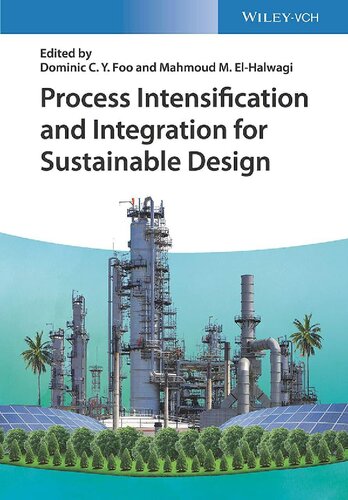

Most ebook files are in PDF format, so you can easily read them using various software such as Foxit Reader or directly on the Google Chrome browser.
Some ebook files are released by publishers in other formats such as .awz, .mobi, .epub, .fb2, etc. You may need to install specific software to read these formats on mobile/PC, such as Calibre.
Please read the tutorial at this link. https://ebooknice.com/page/post?id=faq
We offer FREE conversion to the popular formats you request; however, this may take some time. Therefore, right after payment, please email us, and we will try to provide the service as quickly as possible.
For some exceptional file formats or broken links (if any), please refrain from opening any disputes. Instead, email us first, and we will try to assist within a maximum of 6 hours.
EbookNice Team

Status:
Available4.5
8 reviewsPresents comprehensive coverage of process intensification and integration for sustainable design, along with fundamental techniques and experiences from the industry
Drawing from fundamental techniques and recent industrial experiences, this book discusses the many developments in process intensification and integration and focuses on increasing sustainability via several overarching topics such as Sustainable Manufacturing, Energy Saving Technologies, and Resource Conservation and Pollution Prevention Techniques.
Process Intensification and Integration for Sustainable Design starts discussions on: shale gas as an option for the production of chemicals and challenges for process intensification; the design and techno-economic analysis of separation units to handle feedstock variability in shale gas treatment; RO-PRO desalination; and techno-economic and environmental assessment of ultrathin polysulfone membranes for oxygen-enriched combustion. Next, it looks at process intensification of membrane-based systems for water, energy, and environment applications; the design of internally heat-integrated distillation column (HIDiC); and graphical analysis and integration of heat exchanger networks with heat pumps. Decomposition and implementation of large-scale interplant heat integration is covered, as is the synthesis of combined heat and mass exchange networks (CHAMENs) with renewables. The book also covers optimization strategies for integrating and intensifying housing complexes; a sustainable biomass conversion process assessment; and more.
Process Intensification and Integration for Sustainable Design is an ideal book for process engineers, chemical engineers, engineering scientists, engineering consultants, and chemists.